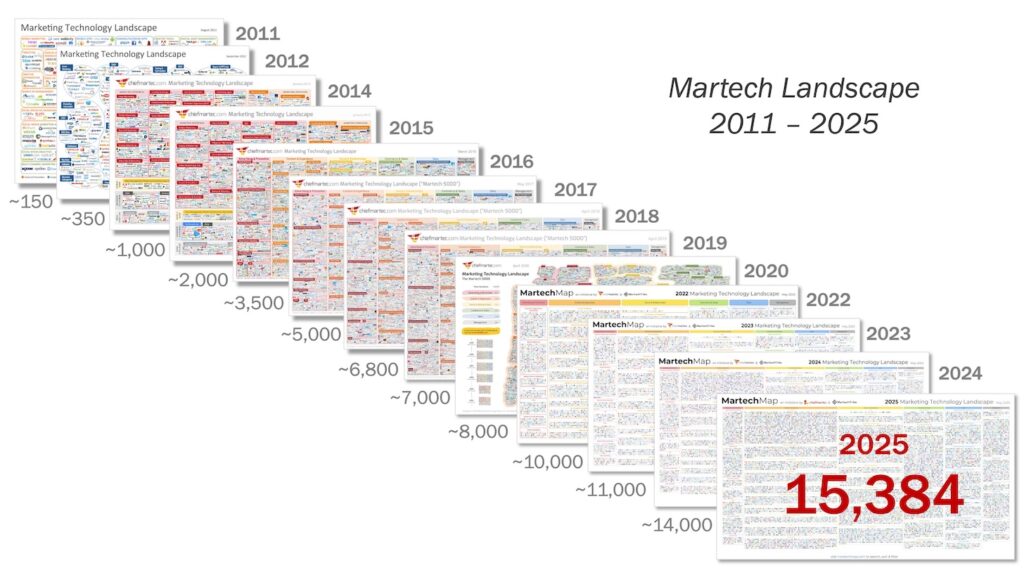Way back in 2011 Chief Martec’s Scott Brinker began tracking marketing applications in the form of a “super graphic”. Scott identified 150 tools in his first edition. Today there are 15,385, a compound annual growth rate of 32.32%.
Scott and his Martech Tribe colleague Frans Riemersma now have created a dedicated platform to assist marketers filter and navigate through their subcategories and options.
They have also produced a comprehensive assessment of AI’s impact on the Martech universe. Despite (and maybe also because of) its 111-page length, Martech for 2025 is well worth reviewing.
As marketers navigate this dynamic era, the report highlights five key segments driving growth and innovation, alongside practical strategies for leveraging AI effectively.
AI-Powered Martech Growth
The surge in Martech tools, which have jumped from 11,038 in 2023 to 15,385 in 2025, shows no sign of slowing down. The growth is largely fueled by AI-powered solutions. These are categorized into five segments:
- Indie Tools: Specialized, AI-native startups focusing on niche marketing tasks like content creation and sales automation.
- Incumbent Platforms: Established players (e.g., Adobe, Salesforce) embedding AI to enhance existing products.
- Challenger Platforms: Emerging platforms leveraging AI to disrupt traditional categories, such as digital experience platforms (DXPs), formerly CMS tools or website Content Management Systems.
- Instant Software: Custom, AI-generated software created on-the-fly to address specific business needs. Salesforce, recognising an emerging commercial threat, is proactively warning against this approach, labelling it DIY AI software.
- Service-as-a-Software: AI-driven solutions that perform tasks autonomously, like customer service or campaign orchestration, often with outcome-based pricing.
Foundations for an AI Strategy
The report reinforces the essential reality that a robust AI strategy hinges on a solid data foundation. Scott and Fran emphasize the importance of a universal data layer. 71% of those who responded to a survey for the report claimed to be using cloud data warehouses (e.g., Snowflake, Google BigQuery) to integrate data across their stacks. Additionally, a universal content layer is emerging to manage personalized content at scale, blending customer data with brand identity for hyper-personalized experiences. API composability is also critical, enabling AI agents to execute actions via large action models (LAMs), which complement large language models (LLMs).
This data challenge is the biggest AI-adoption hurdle for traditional legacy businesses, who, with few exceptions, are yet to genuinely master their myriad data management issues.
Generative AI Use Cases
Generative AI adoption is widespread, with content ideation (69%) and content copy production (62%) leading as the most popular use cases given their obvious low-hanging fruit status. Other notable applications include transcription, summarization, and competitive research. While content and data-related tasks dominate, adoption in advertising and social media is lower, partly due to outsourcing or reliance on platforms like Google’s Performance Max. The report notes that 60% of marketers use both embedded AI in existing tools and new AI-native tools, with frequent use in content and analytics tasks.
Governance and Practical Insights
Only 52% of organizations have a generative AI policy, impacting adoption rates. Those with policies are more likely to cite cost as a reason for discontinuing AI tools, indicating greater maturity in evaluating ROI. The report also highlights the need for governance to address data privacy, security, and compliance concerns.
Key Takeaways
- Experiment Strategically: Start small with AI to test high-impact use cases without overhauling existing systems.
- Prioritize Data: A strong data strategy is essential for unlocking AI’s potential. There is little merit in feeding sophisticated AI engines with poor-quality data fuel.
- Embrace Composability: Build flexible, API-driven stacks to integrate AI seamlessly.
- Focus on Outcomes: Shift from flashy demos to measurable ROI, leveraging AI for efficiency and personalization.
As AI continues to evolve, marketers must balance innovation with governance to harness its transformative power. For a deeper dive, explore the full “Martech for 2025” report.




Leave a Reply